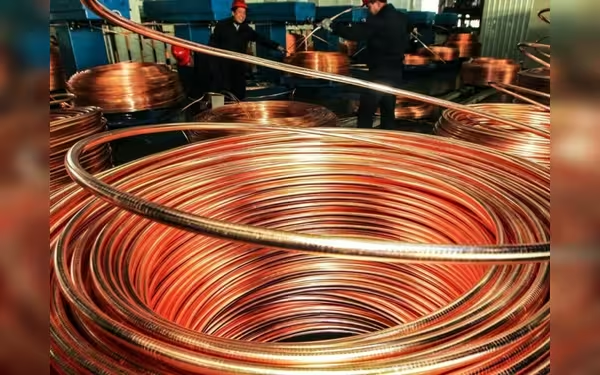Thursday, July 4, 2024 06:03 PM
Copper prices decline due to weakening Chinese industrial output
- Copper prices drop due to China's industrial slowdown
- Speculative buying led to record copper prices in May
- Aluminium output surge in China raises inventory concerns
 Image Credits: brecorder
Image Credits: brecorderRecent decline in copper prices attributed to China's industrial slowdown and global economic factors. Aluminium output surge raises inventory concerns in a complex market environment.
Copper prices have recently faced a decline in response to various economic factors affecting the global market. The weakening of industrial output in China, one of the world's largest consumers of copper, has played a significant role in this downturn. Additionally, the strengthening of the U.S. dollar has further impacted the pricing of commodities, including copper.
The London Metal Exchange reported a 0.4% drop in three-month copper prices, bringing the value to $9,701.50 per metric ton. Similarly, the most-traded July copper contract on the Shanghai Futures Exchange experienced a 1.3% decrease, settling at 78,630 yuan ($10,837.15) per ton. The slowdown in China's industrial output growth to 5.6% in May, below the anticipated 6%, has been attributed to various internal factors such as a downturn in the property market and high local government debt levels.
In May, copper prices had surged to record levels due to speculative buying but have since corrected downwards as Chinese demand did not meet initial expectations. Market analysts are now predicting a further decline in copper prices as the global economic landscape continues to evolve.
While copper prices have experienced a decline, other metal prices have remained relatively stable. LME nickel is currently priced at $17,575 a ton, aluminium at $2,510, tin at $32,440, zinc at $2,780, and lead at $2,165. On the SHFE, nickel declined by 0.8% to 136,230 yuan a ton, aluminium fell by 1.4% to 20,385 yuan, zinc lost 1.6% to 23,290 yuan, tin dropped 1.3% to 267,810 yuan, and lead gained 0.9% to 18,730 yuan.
The recent increase in aluminium output in China, driven by a surge in Russian imports and weak demand from the construction sector, has raised concerns about potential inventory build-up. These developments, coupled with the broader economic challenges such as the strength of the U.S. dollar and uncertainties in Europe's political landscape, have created a complex market environment for commodities.
The fluctuations in copper prices and the broader metal market underscore the interconnected nature of global economies and the impact of various geopolitical and economic factors on commodity pricing. As investors and industry stakeholders navigate these challenges, staying informed about market trends and developments becomes crucial for making informed decisions.













